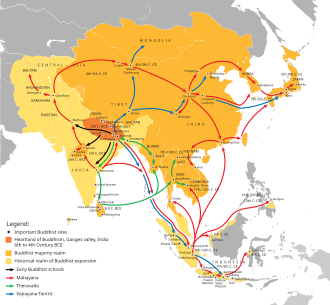
Back بوذية إغريقية Arabic Grecobudismu AST Гръко-будизъм Bulgarian গ্রিকো-বৌদ্ধধর্ম Bengali/Bangla Grecobudisme Catalan Graeco-Buddhismus German Ελληνοβουδισμός Greek Greka Budhismo Esperanto Grecobudismo Spanish Grekobudismo Basque

| Part of a series on |
| Buddhism |
|---|
 |

Greco-Buddhism or Graeco-Buddhism denotes a cultural syncretism between Hellenistic culture and Buddhism developed between the 4th century BC and the 5th century AD in Gandhara, which was in present-day Pakistan and parts of north-east Afghanistan.[2][3][4] While the Greco-Buddhist art shows clear Hellenistic influences, the majority of scholars do not assume a noticeable Greek influence on Gandharan Buddhism beyond the artistic realm.[5][6][7][8][9][10]
Cultural interactions between ancient Greece and Buddhism date back to Greek forays into the Indian subcontinent from the time of Alexander the Great. A few years after Alexander's death, the Easternmost fringes of the empire of his general Seleucus were lost in a war with the Mauryan Empire, under the reign of Chandragupta Maurya. The Mauryan Emperor Ashoka would convert to Buddhism and spread the religious philosophy throughout his domain, as recorded in the Edicts of Ashoka. This spread to the Greco-Bactrian kingdom, which itself seceded from the Seleucid Empire.
Following the collapse of the Mauryan Empire, Buddhism continued to flourish under the Greco-Bactrian Kingdom, Indo-Greek Kingdoms, and Kushan Empire. Mahayana Buddhism was spread from the Gangetic plains in India into Gandhara and then Central Asia during the Mauryan Era, where it became the most prevalent branch of Buddhism in Central Asia. Mahayana Buddhism was later transmitted through the Silk Road into the Han dynasty during the Kushan era under the reign of Emperor Kanishka. Buddhist tradition details the monk, Majjhantika of Varanasi, was made responsible for spreading Buddhism in the region by Emperor Ashoka. Later on, the Greco-Bactrian and Indo-Greek king Menander I, who may have converted to Buddhism, stimulated the spread of the religion as well.
- ^ Acri, Andrea (20 December 2018). "Maritime Buddhism". Oxford Research Encyclopedia of Religion. Oxford: Oxford University Press. doi:10.1093/acrefore/9780199340378.013.638. ISBN 9780199340378. Archived from the original on 19 February 2019. Retrieved 30 May 2021.
- ^ Kubica, Olga (2023). Greco-Buddhist Relations in the Hellenistic Far East. Sources and Contexts. Taylor & Francis Ltd. p. 4. ISBN 978-1-032-19302-1.
- ^ Halkias, Georgios T. (2014). "When the Greeks Converted the Buddha: Asymmetrical Transfers of Knowledge in Indo-Greek Cultures". In Wick, Peter; Rabens, Volker (eds.). Religions and trade: religious formation, transformation and cross-cultural exchange between East and West. Dynamics in the history of religions. Leiden Boston (Mass.): Brill. p. 106. ISBN 978-90-04-25528-9.
- ^ Bhaskar, V. S. (2009). Faith & Philosophy of Buddhism. Gyan Publishing House. ISBN 978-81-7835-722-5. Archived from the original on 2023-01-15. Retrieved 2022-05-18.
- ^ Cite error: The named reference
:4was invoked but never defined (see the help page). - ^ Cite error: The named reference
:5was invoked but never defined (see the help page). - ^ Salomon, Richard (1999). Ancient Buddhist Scrolls from Ghandāra: The British Library Kharosthī Fragments. Washington (Wash.): University of Washington Press. p. 5. ISBN 978-0-295-97769-0.
- ^ Cite error: The named reference
:7was invoked but never defined (see the help page). - ^ Cite error: The named reference
:8was invoked but never defined (see the help page). - ^ Cite error: The named reference
:9was invoked but never defined (see the help page).